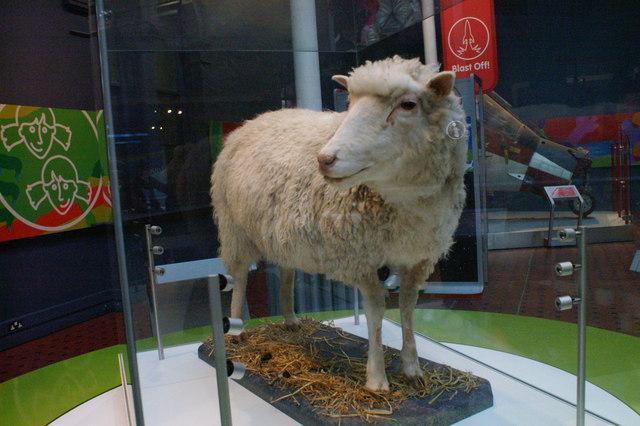How to Make Cloning Pay

Mike Pennington / Dolly the sheep, National
Museums of Scotland, Edinburgh / CC BY-SA 2.0
The first mammal cloned from an adult cell, Dolly the sheep, was born on July 5, 1996. She became a global star, but neither she nor British embryologist Ian Wilmut (her foster daddy) got rich, though Wilmut did eventually receive a knighthood for leading the successful team. Dolly lived a pampered life and died in 2003; her body remains on display at the National Museum of Scotland.
Dolly’s fame triggered widespread speculation about cloning humans and a fad for animal cloning. At least 25 species have now been cloned, and variants on the technology are still being developed: The recent “de-extinction” of “dire wolves” involved cloning regular wolves with a couple of genetic adjustments. In the mid-2000s, a start-up dubbed Genetic Savings & Clone tried to sell cloned cats and dogs but failed to turn the technology into a viable business. Nevertheless, pet cats and dogs have been and are being cloned for the rich and famous; Barbra Streisand reportedly spent $50,000 each to have two clones made of her favorite dog, though apparently they have different personalities than their predecessor.
But what about cloning people? One of the first would-be human cloners, the wonderfully named Dr. Richard Seed (his doctorate was in physics), claimed in 1998 (when he was 70) to have plans to clone hundreds of people, starting with himself and his wife. He did have some experience with embryo transfer in cattle, and had enough credentials to affect the public discourse for a while. Indeed, he was awarded the 1998 Ig Nobel Prize in Economics “for his efforts to stoke up the world economy by cloning himself and other human beings.”
A couple of years later, the Raelians, a religious cult that believed humans were created by alien cloners, took up the story. Just after Christmas 2002, they announced the birth of a cloned baby called — you may have one guess — Eve! They did not turn out to have a working laboratory or anything else beyond a talent for publicity and even that had a short shelf-life.
Enter Hwang Woo-Suk, a South Korean veterinarian and researcher with grand ambitions. Hwang’s first major success was cloning cattle. He then claimed to have created cloned human embryonic stem cells, which at the time was considered a hugely significant scientific breakthrough. Science published two major papers of his in 2004 and 2005. If there was talk of a Nobel Prize, well, he was happy to hear it. But it soon emerged that Hwang had faked the evidence. He had also abused his staff, coercing young women on his research team into providing the hundreds of eggs he used in his cloning experiments, and embezzled large sums of research funds. A major world-wide scandal ensued.
After his fall from grace, Hwang returned to work with animals. Dog cloning offered him a living. Eventually, he moved on to Thailand and then the United Arab Emirates (UAE), where he was called upon to clone a magnificent camel and developed quite a business of re-creating the most successful racing camels. In 2022, he was the corresponding author of a scientific report in a journal that is part of the Nature organization, “Insights from one thousand cloned dogs,” which identifies him as attached to a UAE Biotech Research Center and a University in the Republic of Sakha, Yakutia, Russia. In 2023, Hwang was featured in a movie called King of Clones and seemed to be doing fine.
But he missed this trick: Cloning horses for polo. That’s where the big money is. Wired published a long and excellent piece by Matt Reynolds on July 10, 2025:
Cloning Came to Polo. Then Things Got Truly Uncivilized
A polo legend and a businessman joined forces to copy the player’s greatest horse. But with a single clone worth $800,000, some technologies are a breeding ground for betrayal.
The piece opens with a description of “the final game of the 2016 Argentine Open—the most important polo match of the year in the most polo-obsessed country in the world.” So, though many of us were unaware of it, cloning polo horses is not in itself really news. Indeed, Jon Cohen published this story in Science on December 13, 2016:
Six cloned horses help rider win prestigious polo match
Celebrated rider Adolfo Cambiaso mounts six horses named Cuartetera
And in 2024, Equestrian Living published this by Robyn Willey:
Controversy of Cloning
It’s Not Science Fiction Any More.
The horse cloning was performed by Viagen, which describes itself as the “worldwide leader in cloning the animals we love.” The company has been in the cloning business since 2003, mostly of domestic pets: $50,000 per dog, $25,000 per cat. But for top-level polo horses, add at least one more zero to the price. And if you own that exceptional bloodline, you certainly do not want anyone else to have access to it. The Wired story by Reynolds reads like a TV fantasy, with double-dealing and huge sums of money. And a spice of scientific oddities:
“The problem with cloning—and we don’t know why this is—but some horses have the innate ability to pass along genetic qualities that make them amazing polo ponies. And some you clone and they’re not the same horse,” says the veterinarian Scott Swerdlin. “We don’t know why that is, but for sure Cuartetera has been very successful.”
Humans have always lived as part of nature, in collaboration with other animals, with plants, birds, insects, rocks, weather and so on. We have always affected and been influenced by our surroundings. The very idea of “making cloning pay” is both ridiculous and typical. Perhaps we could move forward with a clearer assessment of our place in this remarkable planet.



